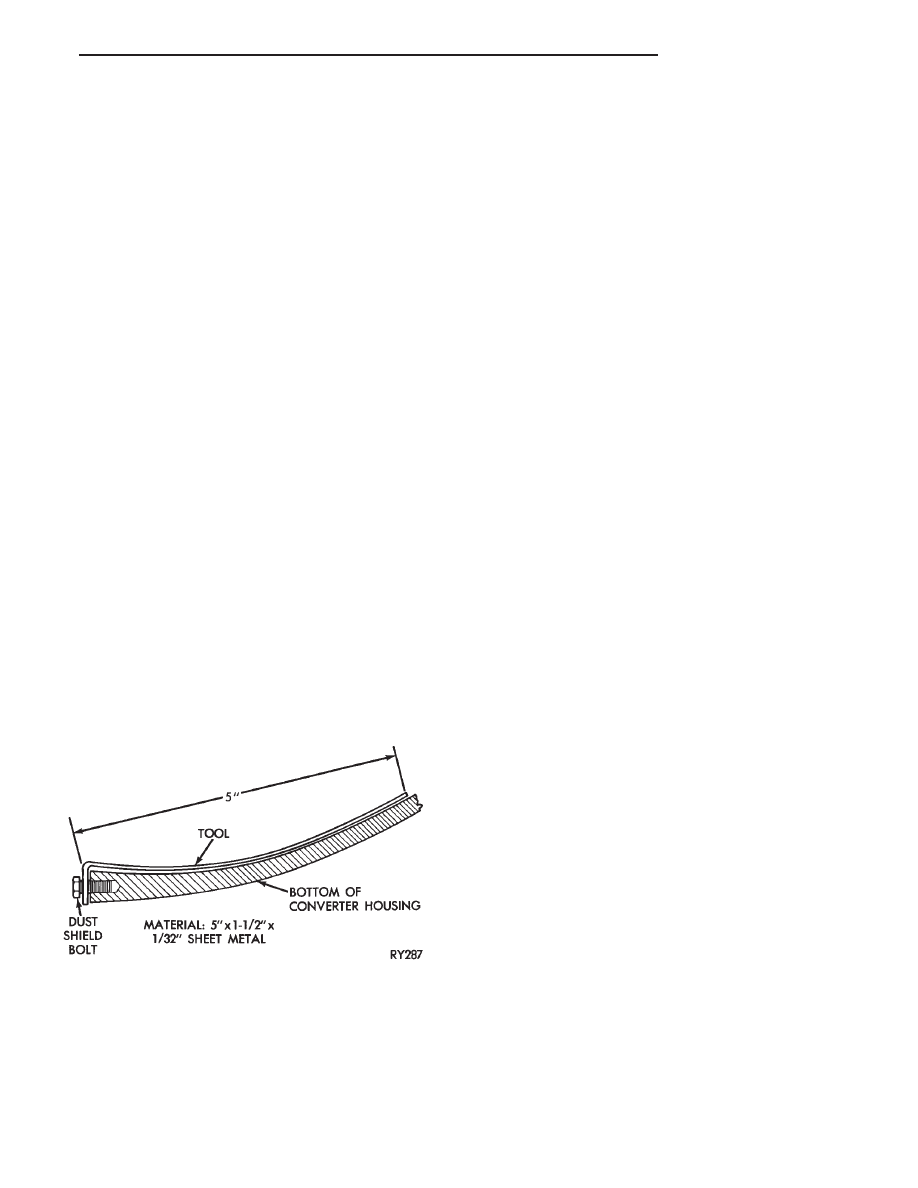Chrysler Le Baron, Dodge Dynasty, Plymouth Acclaim. Manual - part 123

first separator plate and watch carefully for the pis-
ton to move forward. The piston should return to its
original position after the air pressure is removed.
UNDERDRIVE CLUTCH
Because this clutch piston cannot be seen, its oper-
ation is checked by function. Air pressure is applied
to the low/reverse and the 2/4 clutches. This locks
the output shaft. Use a piece of rubber hose wrapped
around the input shaft and a pair of clamp-on pliers
to turn the input shaft. Next apply air pressure to
the underdrive clutch. The input shaft should not ro-
tate with hand torque. Release the air pressure and
confirm that the input shaft will rotate.
FLUID LEAKAGE-TORQUE CONVERTER HOUSING
AREA
(1) Check for source of leakage.
Since fluid leakage at or around the torque con-
verter area may originate from an engine oil leak,
the area should be examined closely. Factory fill
fluid is dyed red and, therefore, can be distinguished
from engine oil.
(2) Prior to removing the transaxle, perform the
following checks:
When leakage is determined to originate from the
transaxle, check fluid level prior to removal of the
transaxle and torque converter.
High oil level can result in oil leakage out the vent
in the manual shaft. If the fluid level is high, adjust
to proper level.
After performing this operation, inspect for leak-
age. If a leak persists, perform the following opera-
tion on the vehicle to determine if it is the torque
converter or transaxle that is leaking.
LEAKAGE TEST PROBE
(1) Remove torque converter housing dust shield.
(2) Clean the inside of torque converter housing
(lower area) as dry as possible. A solvent spray fol-
lowed by compressed air drying is preferable.
(3) Fabricate and fasten test probe (Fig. 4) securely
to convenient dust shield bolt hole. Make certain
torque converter is cleared by test probe. Tool must be
clean and dry.
(4) Run engine at approximately 2,500 rpm with
transaxle in neutral, for about 2 minutes. Transaxle
must be at operating temperature.
(5) Stop engine and carefully remove tool.
(6) If upper surface of test probe is dry, there is no
torque converter leak. A path of fluid across probe
indicates a torque converter leak. Oil leaking under the
probe is coming from the transaxle torque converter
area.
(7) Remove transaxle and torque converter assembly
from vehicle for further investigation. The fluid should
be drained from the transaxle. Re install oil pan (with
MOPAR
t Adhesive Sealant) at specified torque.
Possible sources of transaxle torque converter area
fluid leakage are:
(1) Torque converter hub seal.
• Seal lip cut, check torque converter hub finish.
• Bushing moved and/or worn.
• Oil return hole in pump housing plugged or omitted.
• Seal worn out (high-mileage vehicles).
(2) Fluid leakage at the outside diameter from pump
housing O-ring.
(3) Fluid leakage at the front pump to case bolts.
Check condition of washers on bolts and use new bolts,
if necessary.
(4) Fluid leakage due to case or front pump housing
porosity.
TORQUE CONVERTER LEAKAGE
Possible sources of torque converter leakage are:
• Torque converter weld leaks at the out side (periph-
eral) weld.
• Torque converter hub weld.
Hub weld is inside and not visible. Do not
attempt to repair. Replace torque converter.
If the torque converter must be replaced, refer
to Torque Converter Clutch Break-in Procedure
in this section. This procedure will reset the
transmission control module break-in status.
Failure to perform this procedure may cause
transaxle shutter.
AIR PRESSURE TEST OF TRANSAXLE
Fabricate equipment needed for test as shown in
Figures 5 and 6.
The transaxle should be prepared for pressure test as
follows after removal of the torque converter:
(1) Plug dipstick tube and plug oil cooler line fitting.
Remove vent from manual shaft and in stall a 1/8 inch
pipe plug.
Fig. 4 Leak Locating Test Probe Tool
Ä
TRANSAXLE
21 - 97